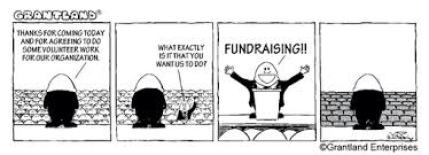
This post is a complement to a podcast episode of Social Entrepreneur with Nathan A. Webster, of which I am a monthly contributor. Listen below!
After last month’s topic of social media and #GivingTuesday, I wanted to dig in a little further to a subset of that topic: crowdfunding and peer to peer fundraising. It’s a great way to get exposure to your cause and get access to a new donor pool.
First, let’s do some quick explanations of what exactly crowdfunding and peer to peer fundraising are.
Crowdfunding is online fundraising for a specific project that is designed to be funded through many people with smaller donations – namely, by a crowd. If you’ve heard of platforms like GoFundMe, that’s an example of a crowdfunding campaign – GoFundMe actually even has a platform designed for nonprofits called CrowdRise. Crowdfunding campaigns are usually started or come from the nonprofit itself.
Peer to peer fundraising takes crowdfunding one step further – it’s the idea that fans of the nonprofit become fundraisers themselves. They create their own profile page where they can share their story and make an ask, then ask their friends to donate to their campaign. Most all of this work is done online.
Now that we’ve defined the terms… let’s talk about some best practices for them.
Crowdfunding
Don’t create a crowdfunding campaign just because it seems like the thing to do. Be thoughtful, and make sure you have these things in place before you put together a crowdfunding campaign:
- A specific, tangible ask: General operating asks are usually not very successful when it comes to crowdfunding campaigns. Special projects, one time events, or unique programs are the best thing to ask for. Make sure it’s something that people can feel good about being part of and that they can see how it’s making a difference. Having it be something that’s one time makes it feel more compelling.
- A short timeline: To create a sense of urgency, try keeping to a timeline of 4-6 weeks for your crowdfunding campaign. It’s enough time for people to share and participate in the way that feels best, but not too long that it feels like it’s not special.
- Enough person-power to manage it: Like any other type of campaign, you need to have a plan in place and enough time to send emails, post on social media, and maintain the page. But in addition to that, make sure you have enough time to manage technology glitches, questions from donors, and other last minute things that come up. You can’t just slap up a page and leave it – make sure you have enough time to stay with it.
- Goals around both fundraising and marketing: Crowdfunding is not necessarily going to yield you as much money as many of the other traditional sources of donations. But: it could yield you more donors and a lot of eyeballs on your campaign and your work. So think of your campaign in both senses.
If you think you have a good idea for a crowdfunding campaign… you can amplify it even more with a peer to peer element to it
Peer to Peer
- Make it easy: Make sure the process of setting up a fundraising page is very easy. Plug in some template information that automatically populates a page, just in case people just want to set it up and go. Put together a toolkit where people can grab content for emails, social media posts, and other outreach. You can even offer phone check ins for people who want some additional coaching.
- Encourage story telling & acknowledgment: The more genuine and authentic the asks are, the better. So keep reminding your fundraisers to be transparent about their story and connection to the cause and why they are raising money for the nonprofit. The more compelling the story, the more convincing the ask. They can do this in thanking their donors, too.
- Use incentives: Don’t spend a ton of time and money on gifts, but think about rewards to drive your fundraisers to keep spreading the message. There are lots of ways you can structure this: rewards for the most donations, the most donors, the most shares (you can track it through using hashtags). Or you can always have a drawing for something that anyone who shares a certain amount of times is entered into.
Crowdfunding and peer to peer fundraising can be a great source of exposure and revenue from a new donor pool. Hopefully these tips can help you envision how to put together a successful campaign!
-N.C.








